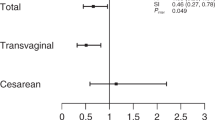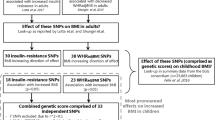Abstract
Objective:
Birth weight reflects prenatal metabolic adaption and has been related to later-life obesity risk. This study aimed to evaluate whether birth weight modifies the effect of genetic susceptibility on obesity risk in young Chinese.
Methods:
We recruited 540 young (14–30 years) and obese patients (body mass index, BMI⩾30 kg m−2), and 500 age- and sex-matched normal-weight healthy individuals (BMI<23 kg m−2). We genotyped 23 BMI-associated genetic variants identified from recent genome-wide association studies (GWAS) in Caucasians with European ancestry with minor allele frequency>0.05 in HapMap Han Chinese in Beijing, China.
Results:
Six loci, including SEC16B, GNPDA2, BDNF, FTO, MC4R and TMEM160, were significantly associated with obesity risk, with odds ratio from 1.314 to 1.701. The 23 risk loci accounted for 6.38% of the genetic variance in obesity. We created two genetic risk scores (GRSs) by summing the risk alleles of all 23 (GRS1) and 6 obesity-associated (GRS2) genetic variants. Prediction of obesity was significantly improved (P<0.001) when the GRS1 and GRS2 were added to a model with age and gender, with improvement of discrimination for obesity by 0.8% and 2.7%, respectively. In addition, we found that the two GRSs interacted with birth weight in relation to obesity (Pinteraction<0.001). The genetic effect appeared to be more pronounced in individuals with normal range of birth weight (25–75%) than those with either low (<25%) or high (>75%) birth weight.
Conclusion:
We confirmed the associations of the single-nucleotide polymorphism tagging six loci reported in recent GWAS with obesity in young Chinese. Our data also suggest birth weight may significantly modify genetic susceptibility to obesity risk.
This is a preview of subscription content, access via your institution
Access options
Subscribe to this journal
Receive 12 print issues and online access
$259.00 per year
only $21.58 per issue
Buy this article
- Purchase on Springer Link
- Instant access to full article PDF
Prices may be subject to local taxes which are calculated during checkout


Similar content being viewed by others
References
Wang Y, Mi J, Shan XY, Wang QJ, Ge KY . Is China facing an obesity epidemic and the consequences? The trends in obesity and chronic disease in China. Int J Obes 2007; 31: 177–188.
Wu Y . Overweight and obesity in China. BMJ 2006; 333: 362–363.
McCarthy MI . Genomics, type 2 diabetes, and obesity. N Engl J Med 2010; 363: 2339–2500.
Dorajoo R, Blakemore AI, Sim X, Ong RT, Ng DP, Seielstad M et al. Replication of 13 obesity loci among Singaporean Chinese, Malay and Asian-Indian populations. Int J Obes 2012; 36: 159–163.
Yu ZB, Han SP, Zhu GZ, Zhu C, Wang XJ, Cao XG et al. Birth weight and subsequent risk of obesity: a systematic review and meta-analysis. Obes Rev 2011; 12: 525–542.
Lillycrop KA, Burdge GC . Epigenetic changes in early life and future risk of obesity. Int J Obes 2011; 35: 72–83.
Mei H, Chen W, Srinivasan SR, Jiang F, Schorket N, Murray S et al. FTO influences on longitudinal BMI over childhood and adulthood and modulation on relationship between birth weight and longitudinal BMI. Hum Genet 2010; 128: 589–596.
WHO Expert Consultation Appropriate body-mass index for Asian populations and its implications for policy and intervention strategies. Lancet 2004; 363: 157–163.
Speliotes EK, Willer CJ, Berndt SI, Monda KL, Thorleifsson G, Jackson AU et al. Association analyses of 249 796 individuals reveal 18 new loci associated with body mass index. Nat Genet 2010; 42: 937–948.
Balding DJ . A tutorial on statistical methods for population association studies. Nat Rev Genet 2006; 7: 781–791.
Barrett JC, Hansoul S, Nicolae DL, Cho JH, Duerr RH, Rioux JD et al. Genome-wide association defines more than 30 distinct susceptibility loci for Crohn’s disease. Nat Genet 2008; 40: 955–962.
Gateva V, Sandling JK, Hom G, Taylor KE, Chung SA, Sun X et al. A large scale replication study identifies TNIP1, PRDM1, JAZF1, UHRF1BP1 and IL10 as risk loci for systemic lupus erythematosus. Nat Genet 2009; 41: 1228–1233.
Piccolo SR, Abo RP, Allen-Brady K, Camp NJ, Knight S, Anderson JL et al. Evaluation of genetic risk scores for lipid levels using genome-wide markers in the Framingham Heart Study. BMC Proc 2009; 3: S46.
Henseler T . Genetics of psoriasis. Arch Dermatol Res 1998; 290: 463–476.
Thorleifsson G, Walters GB, Gudbjartsson DF, Steinthorsdottir V, Sulem P, Helgadottir A et al. Genome-wide association yields new sequence variants at seven loci that associate with measures of obesity. Nat Genet 2009; 41: 18–24.
Willer CJ, Speliotes EK, Loos RJ, Li S, Lindgren CM, Heid IM et al. Six new loci associated with body mass index highlight a neuronal influence on bodyweight regulation. Nat Genet 2009; 41: 25–34.
Sandholt CH, Sparsø T, Grarup N, Albrechtsen A, Almind K, Hansen L et al. Combined analyses of 20 common obesity susceptibility variants. Diabetes 2010; 59: 1667–1673.
Janssens AC, Moonesinghe R, Yang Q, Steyerberg EW, Van Duijn CM, Khoury MJ . The impact of genotype frequencies on the clinical validity of genomic profiling for predicting common chronic diseases. Genet Med 2007; 9: 528–535.
Kilpeläinen TO, den Hoed M, Ong KK, Grøntved A, Brage S, Jameson K et alEarly Growth Genetics Consortium. Obesity-susceptibility loci have a limited influence on birth weight: a meta-analysis of up to 28 219 individuals. Am J Clin Nutr 2011; 93: 851–860.
Andersson EA, Pilgaard K, Pisinger C, Harder MN, Grarup N, Færch K et al. Do gene variants influencing adult adiposity affect birth weight? A population-based study of 24 loci in 4744 Danish individuals. PLoS One 2010; 5: e14190.
Sørensen HT, Sabroe S, Rothman KJ, Gillman M, Fischer P, Sørensen TI et al. Relation between weight and length at birth and body mass index in young adulthood: cohort study. BMJ 1997; 315: 1137.
Curhan GC, Chertow GM, Willett WC, Spiegelman D, Colditz GA, Manson JE et al. Birth weight and adult hypertension and obesity in women. Circulation 1996; 94: 1310–1315.
Curhan GC, Willett WC, Rimm EB, Spiegelman D, Ascherio AL, Stampfer MJ et al. Birth weight and adult hypertension, diabetes mellitus, and obesity in US men. Circulation 1996; 94: 3246–3250.
Ong KK, Ahmed ML, Emmett PM, Preece MA, Dunger DB . the ALSPAC Study Team. Association between postnatal catch-up growth and obesity in childhood: prospective cohort study. BMJ 2000; 320: 967–971.
Gale CR, Martyn CN, Kellingray SD, Eastell R, Cooper C . Intrauterine programming of adult body composition. J Clin Endocrinol Metab 2001; 86: 267–272.
Broyles S, Katzmarzyk PT, Srinivasan SR, Chen W, Bouchard C, Freedman DS et al. The pediatric obesity epidemic continues unabated in Bogalusa, Louisiana. Pediatrics 2010; 125: 900–905.
Webber LS, Wattigney WA, Srinivasan SR, Berenson GS . Obesity studies in Bogalusa. Am J Med Sci 1995; 310: S53–S61.
Acknowledgements
This study was supported by the grants from the National Key Technologies Research and Development Program (2008ZX09312-0191200), the National Natural Science Foundation of China (No. 30700383, 30971077, 81030011, 81070670, 81170712), the Shanghai Science and Technology Commission (10dz1920802), the Ministry of Health on Research for special purpose (201002002 and 201202008), and the Key Project of Shanghai Science and Technology Commission on Biological Medicine (09411954400).
Author information
Authors and Affiliations
Corresponding author
Ethics declarations
Competing interests
The authors declare no conflict of interest.
Additional information
Supplementary Information accompanies the paper on International Journal of Obesity website
Supplementary information
Rights and permissions
About this article
Cite this article
Hong, J., Shi, J., Qi, L. et al. Genetic susceptibility, birth weight and obesity risk in young Chinese. Int J Obes 37, 673–677 (2013). https://doi.org/10.1038/ijo.2012.87
Received:
Revised:
Accepted:
Published:
Issue Date:
DOI: https://doi.org/10.1038/ijo.2012.87
Keywords
This article is cited by
-
The association between polymorphisms near TMEM18 and the risk of obesity: a meta-analysis
BMC Medical Genomics (2021)
-
Dietary patterns interact with the variations of 18q21.23 rs17782313 locus on regulation of hypothalamic-pituitary axis hormones and cardio-metabolic risk factors in obesity
Eating and Weight Disorders - Studies on Anorexia, Bulimia and Obesity (2020)
-
Gpnmb secreted from liver promotes lipogenesis in white adipose tissue and aggravates obesity and insulin resistance
Nature Metabolism (2019)
-
FTO gene polymorphisms and obesity risk in Chinese population: a meta-analysis
World Journal of Pediatrics (2019)
-
Interactions with the MC4R rs17782313 variant, mental stress and energy intake and the risk of obesity in Genome Epidemiology Study
Nutrition & Metabolism (2016)



